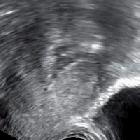sonohysterography

Sonohysterography, also referred as saline-induced sonohysterography (SIS), is an ultrasound technique that better characterizes the uterine cavity and endometrium. It is particularly useful for evaluation of endometrial polyps.
Indications
- fertility evaluation / recurrent pregnancy loss
- intrauterine adhesions
- screening before in-vitro fertilisation (IVF)
- endometrial polyps, endometrial hyperplasia, endometrial carcinoma
- SIS has better sensitivity for these lesions than normal endovaginal pelvic ultrasound
- useful when there is discordance between pelvic ultrasound and endometrial biopsy
- congenital uterine anomalies (3D ultrasound or pelvic MRI may be better options)
- postmenopausal bleeding
- submucosal fibroids
- retained products of conception
Contraindications
- pregnancy
- performing the study after day 14 in a woman's menstrual cycle is a relative contraindication
- pelvic inflammatory disease
- the presence of an intrauterine device (IUD)
Procedure
A conventional endovaginal ultrasound of the pelvis should be performed before the sonohysterogram.
The study should be scheduled for days 4-7 in a woman's menstrual cycle. This is not as necessary in patients with abnormal uterine bleeding who are not sure about their cycle time points.
Positioning/room set up
- some administer a NSAID one hour before the study
- prophylactic antibiotics are not usually necessary
- doxycycline may be administered if the fallopian tubes were previously shown to be dilated
- patient consent should be obtained
Equipment
- speculum
- 20 ml syringe
- hysterosonography catheter and 3 ml syringe for the catheter balloon
Technique
The catheter should be flushed with saline to eliminate air.
The patient is put in the lithotomy position and after identification of the cervix with the speculum, the cervix is prepped with iodine.
Then the catheter is introduced into the uterine cavity through the cervical os, and the balloon is inflated when past the cervix.
5-30 ml of warm sterile saline is then injected slowly during ultrasound imaging of the uterus. Imaging is performed in the coronal and sagittal planes. Sonographic volumes can be obtained for 3D ultrasound.
Some leave the speculum in place during the exam, but it may obscure visualization with the endovaginal probe.
Make sure to image the lower uterine segment while the balloon is being deflated and removed.
Complications
Mild cramping and spotting are possible post-procedure adverse events.
There is a very small risk of bleeding and infection/endometritis (<1%) .
Practical points
- always make sure to flush the catheter before use
- infuse saline slowly to avoid a vasovagal reaction
- hemorrhage or clots in the uterus may lead to false-positive findings
- do not forget that although perhaps routine to the doctor and staff, the procedure may cause anxiety and sensitivity to the patient experience is critical
- appropriate draping is critical
- male and female physicians should be chaperoned by a female nurse or physician assistant
- do not forget to do a quick physical exam of the outer genitalia and with the speculum before the procedure


